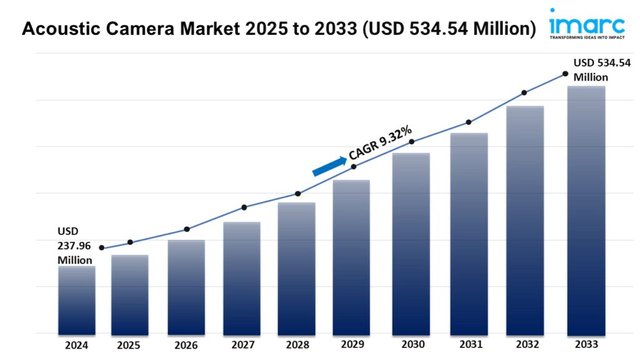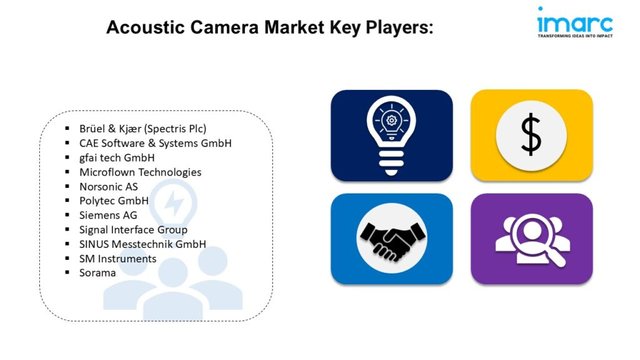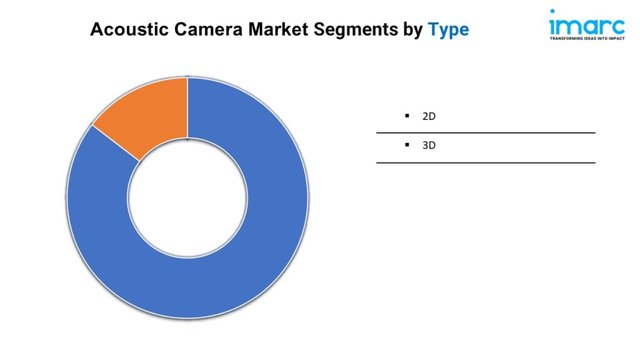Acoustic Camera Market Report Size, Growth, and Trends Forecast 2025-2033
IMARC Group's report titled "Acoustic Camera Market Report by Array Type (2D, 3D), Measurement Type (Far Field, Near Field), Application (Noise Source Detection, Leak Detection, and Others), End Use (Aerospace and Defense, Infrastructure, Energy and Power, Automotive, and Others), and Region 2025-2033". The global acoustic camera market size was valued at USD 237.96 Million in 2024. Looking forward, IMARC Group estimates the market to reach USD 534.54 Million by 2033, exhibiting a CAGR of 9.32% from 2025-2033.

For an in-depth analysis, you can refer sample copy of the report: https://www.imarcgroup.com/acoustic-camera-market/requestsample
Factors Affecting the Growth of the Acoustic Camera Industry:
-
Increasing Demand for Noise Source Identification:
There is a growing requirement for an accurate identification of noise sources across industries, which propels the growth of the acoustic camera market. From real-time visualization and mapping of sound sources in the specific environment, acoustic cameras can be used in industries such as automotive, aerospace, and manufacturing, as well as environmental monitoring to identify and locate unwanted noise sources. Such capability is essential for quality control, product development, and adherence to noise regulations, thereby promoting the adoption of acoustic camera technology.
-
Advancements in Sensor Technologies:
Technological development in sensor technologies, however, continues to advance the acoustic camera market. High-resolution microphones coupled with modern signal processing algorithms optimize the accuracy and efficiency of acoustic cameras in capturing and analyzing sound data. New sensor technologies can improve spatial resolution as well as precisely identify and analyze complex sound patterns. Growing development of sensor technologies increasingly sophisticates acoustic cameras toward many applications with consequent market growth.
-
Stringent Noise Regulations and Environmental Concerns:
Demand for acoustic cameras is being driven by the strict noise control regimes implemented by governments and the increasingly evident concern over the environment. The industries are under pressure to comply with numerous noise emission standards put up as regulations for minimizing the environmental effects of their operations. Acoustic cameras are useful to detect and reduce noise, thus enabling companies to comply with their legislative and environmental corporate sustainability requirements. Corporate social responsibility emphasis and the need for sustainability in production were the additional incentive factors driving up the adoption of sound camera solutions across multiple industrial sectors.
Leading Companies Operating in the Global Acoustic Camera Industry:

-
Brüel & Kjær (Spectris Plc)
-
CAE Software & Systems GmbH
-
gfai tech GmbH
-
Microflown Technologies
-
Norsonic AS
-
Polytec GmbH
-
Siemens AG
-
Signal Interface Group
-
SINUS Messtechnik GmbH
-
SM Instruments
-
Sorama
Acoustic Camera Market Report Segmentation:
By Array Type:

-
2D
-
3D
3D dominates the market due to its superior ability to provide a comprehensive and accurate representation of sound sources in three-dimensional space. This array type is preferred for applications requiring precise localization and visualization of noise sources in various industries.
By Measurement Type:
-
Far Field
-
Near Field
Near field dominates the market due to its effectiveness in capturing detailed sound data in close proximity to the source. Near-field measurement is crucial for applications where accurate identification and analysis of noise sources are required, making it a preferred choice in diverse industrial settings.
By Application:
-
Noise Source Detection
-
Leak Detection
-
Others
Noise source detection dominates the market due to the widespread use of acoustic cameras in identifying and mapping sound sources. Industries such as manufacturing, automotive, aerospace, and environmental monitoring heavily rely on noise source detection for quality control, product development, and compliance with regulatory standards.
By End Use:
-
Aerospace and Defense
-
Infrastructure
-
Energy and Power
-
Automotive
-
Others
Automotive dominates the market due to the significant adoption of acoustic cameras in the automotive industry. The use of acoustic cameras during the design and prototyping phases for identifying and eliminating unwanted noises, such as buzz, squeak, and rattle (BSR) sounds, enhances product quality and contributes to the dominance of the automotive sector in the market.
Regional Insights:
-
North America: (United States, Canada)
-
Asia Pacific: (China, Japan, India, South Korea, Australia, Indonesia, Others)
-
Europe: (Germany, France, United Kingdom, Italy, Spain, Russia, Others)
-
Latin America: (Brazil, Mexico, Others)
-
Middle East and Africa
Asia Pacific dominates the market due to the region's increasing industrialization, particularly in manufacturing and automotive sectors. The demand for acoustic cameras in Asia Pacific is driven by the growing emphasis on quality control, regulatory compliance, and environmental concerns, making it the leading region in the global acoustic camera market.
Global Acoustic Camera Market Trends:
The market is experiencing growth driven by the increasing automation of diverse industrial processes. Acoustic cameras play a crucial role in this context, being extensively utilized for the identification and localization of sound frequencies to detect material defects and prevent equipment or infrastructure failure. Additionally, the automotive industry's significant global growth contributes positively to the market. Acoustic cameras find application in vehicles during design and prototyping phases to eliminate transient, intermittent, and ill-defined noise sources, specifically addressing buzz, squeak, and rattle (BSR) sounds. Furthermore, the widespread adoption of acoustic cameras in advanced non-destructive testing (NDT) equipment adds to the market's positive trajectory. Various technological advancements, such as the development of combined audio and video acoustic cameras, are serving as growth-inducing factors. These innovative variants are employed for traffic control and video recording of vehicles exceeding permitted noise limits. Other contributing factors include increasing public awareness about noise pollution and the implementation of favorable government policies, collectively anticipated to drive the market's growth.
Note: If you need specific information that is not currently within the scope of the report, we will provide it to you as a part of the customization.
About Us:
IMARC Group is a global management consulting firm that helps the world’s most ambitious changemakers to create a lasting impact. The company provide a comprehensive suite of market entry and expansion services. IMARC offerings include thorough market assessment, feasibility studies, company incorporation assistance, factory setup support, regulatory approvals and licensing navigation, branding, marketing and sales strategies, competitive landscape and benchmarking analyses, pricing and cost research, and procurement research.
Contact Us:
IMARC Group
134 N 4th St. Brooklyn, NY 11249, USA
Email: [email protected]
Tel No:(D) +91 120 433 0800
United States: +1-631-791-1145 | United Kingdom: +44-753-713-2163